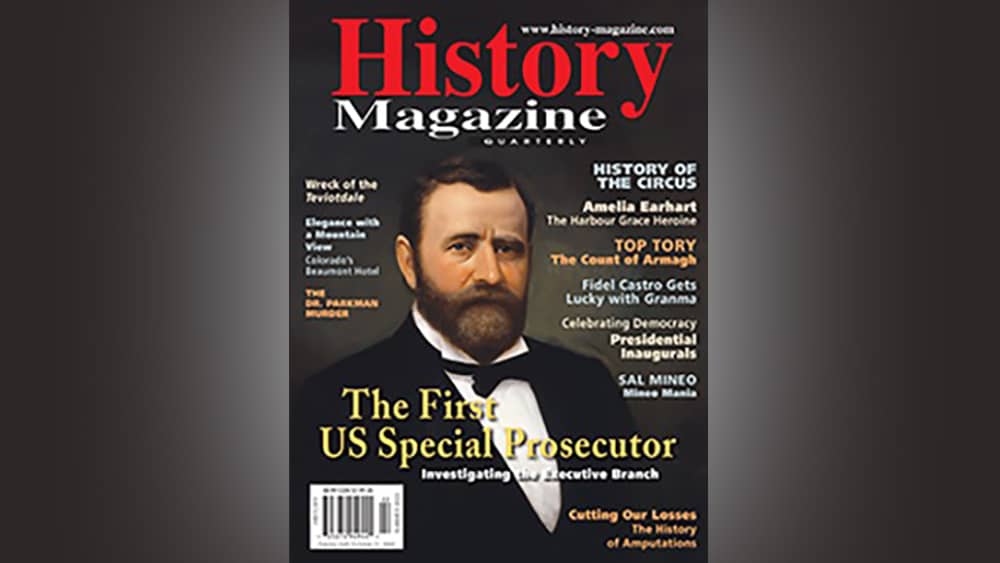
LOUISIANA, Mo. — Pike County’s John Brooks Henderson is featured in a new national publication.
The lead article in the summer issue of the quarterly “History Magazine” is entitled “The First U.S. Special Prosecutor”
It looks at Henderson’s major role in the Whiskey Ring trials of 1875. The author is Fred Lucas, chief national affairs correspondent for The Daily Signal.
“Ulysses S. Grant and John Brooks Henderson each played giant roles in smashing American slavery,” the article begins. “Grant did it on the battlefield. Henderson did it from the Senate floor, as one of the original authors of the Thirteenth Amendment to the Constitution. A decade after the war’s end – the two would be on a collision course in one of the most storied political scandals in American history.”
The Whiskey Ring was a huge scam that involved millions of dollars and multiple cities, with St. Louis being the epicenter. It began in 1871 as a way of diverting federal government taxes on liquor to supporters of President Ulysses S. Grant, who successfully ran for re-election the following year.
Grant did not have direct knowledge of the scandal and was never accused of fraud, but several of his closest aides were in it up to their eyeballs. The chicanery was uncovered in 1874. More than 200 people were indicted.
Though both Republicans, Grant and Henderson disliked each other. The president’s first choice for special prosecutor was Pike County lawyer David Patterson Dyer. Instead of taking the position, Dyer recommended his friend Henderson.
Grant famously said “Let no guilty man escape if it can be avoided.” One of the most egregious defendants, ring instigator John McDonald, would later call schemers in the Grant administration a “coterie of barnacles.”
While McDonald and many others were convicted or pleaded guilty, the president’s private secretary maintained he was “absolutely innocent.” Gen. Orville Babcock had been an aide to Grant during the Civil War. Time magazine would later call Babcock a “schemer of unusually insidious brilliance.”
Before the general faced a jury, Grant canned Henderson. The decision came after the prosecutor accused Babcock of obstructing justice and questioned Grant’s right to “interfere with the honest discharge” of the Treasury Department’s duties.
Henderson believed he did all possible to avoid implicating Grant, but said the president had been “grossly deceived and imposed upon by men who professed to be his friends, here (in St. Louis) and in Washington.” He remained defiant.
“I said nothing beyond what my sworn duty required and, for that, I have no apology to make,” Henderson said.
Dyer was tasked with finding a replacement. His first choice, Northeast Missouri attorney Samuel Glover, turned him down. Dyer then turned to James Overton Broadhead, a Democrat lawyer from Bowling Green. Broadhead accepted the position, even though he had just five weeks to prepare for the pivotal trial.
Three of the 12-member jury – which the St. Louis Post-Dispatch reported was made up of “seven farmers, three blacksmiths, a wagonmaker and a bricklayer” – were from Northeast Missouri, and the pool from which they were chosen included 55-year-old Pike County pioneer farmer John Shannon of Louisiana. They would witness history.
“This scandal had sullied Grant’s good name and his good friend,” Lucas writes. “To clear up both, he would do something no other president had ever done – testify in a criminal trial.”
Grant wanted to go to St. Louis and answer questions, but his staff convinced him to avoid the spectacle and be deposed at the White House.
“I have always had great confidence in his integrity and efficiency,” Grant said of Babcock. “And as yet, my confidence in him is unshaken. I have never learned anything that would shake that confidence.”
The jury was swayed by the president’s words and Babcock was acquitted. Two months later, he was indicted in the Safe Burglary Conspiracy – an effort to influence the prosecution of corrupt building contractors in Washington, D.C. – but again was not convicted. Grant appointed Babcock as chief inspector of lighthouses. He died at age 48 in 1884 when his boat capsized during a storm in Florida.
Before leaving office, Grant pardoned McDonald. The president died just after completing his memoirs at age 63 in 1885. Five years earlier, an apparently ungrateful McDonald had written a tell-all book in which he claimed Grant and Babcock had been complicit in the Whiskey Ring. Few believed him. McDonald died at 80 in 1912.
In August 1876, Grant fired Dyer, too – from his job as U.S. Attorney for the Eastern District of Missouri. He was named to the position again in 1902 and five years later was appointed a federal judge by Republican President Theodore Roosevelt. Dyer died at 86 in 1924.
Broadhead was the first president of the American Bar Association, and served as a congressman and an ambassador. He passed at 79 in 1898.
By 1877, Henderson was back in the good graces of the Republican Party and would continue to defend constitutional freedoms while promoting the rule of law. He died at 86 in 1913.
“Today, the names of Robert Mueller, Kenneth Starr and Archibald Cox have become almost as famous as the presidents they investigated,” Lucas said. “But Henderson was the first special prosecutor named to investigate the executive branch with some degree of autonomy.”